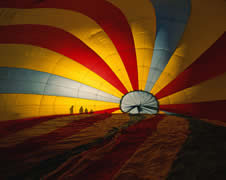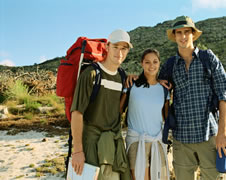|
New Mexico
Value Times are January, April, May, November and December.
Excludes Holidays and Special Events
New Mexico is knee-deep in the mystical and the mysterious. Disappearing civilizations, secret atomic test sites, Native American healers, divine dirt and miraculous staircases are just some of the things you'll find that are hard to explain. While the unknowable can be fun, it's only a part of New Mexico's allure. The mountains and desert are breathtaking and thrilling to hike, bike, ski or raft through.
Your Destination:
Santa Fe
Much of the arid Southwest is referred to as big-sky country, and Santa Fe is no exception. Here you will see some of the most spectacular sunsets to be had in the country, and it seems to have had an effect on the locals—they're some of the friendliest folks you’ll meet.
There's a definite upscale flavor to Santa Fe that appeals to travelers who like the best of everything. But the city offers anyone who visits a distinctive travel experience—delicious food, one-of-a-kind museums and lots of galleries full of fine art.
Above all, it's the look and feel of the town that makes it a desirable destination. Its rich cultural heritage can be seen everywhere you look—from the Native Americans selling goods on the Plaza to the Hispanic influence of its chili-powered delicacies. Most striking are the brown adobe buildings that sit along the twisting streets. They're most impressive in the late-day sun, when the entire city becomes luminescent.
DINING
New Mexican cuisine is a delicious combination of Native American, Spanish-colonial and Anglo frontier cooking. Part of its uniqueness comes from the way the cooks use chili peppers: The food is earthy and spicy, yet refined—all at the same time. Especially good are blue-corn tortillas, carne adovada (marinated baked pork), enchiladas, posole (a marvelously hearty stew of hominy and pork), burritos, sopaipillas (deep-fried bread that accompanies an entree or is served with honey as dessert) and rellenos (fried, stuffed chilies). Many of the dishes are liberally covered with sauces of red or green chilies, cheese and/or sour cream.
SHOPPING
New Mexico offers an excellent selection of Native American and Hispanic arts and crafts. Topping the list, both in price and beauty, is the pottery from such pueblos as Santa Clara, San Ildefonso and Acoma. Some of the works are of museum quality and are well known to art collectors throughout the world. Other possibilities include baskets, jewelry (especially silver and turquoise), animal fetishes (figures carved from stone), Navajo rugs, storyteller dolls (pottery portraying a woman—usually—with any number of children climbing all over her), woven Spanish and Native American rugs, sweaters, kachinas (Native American doll-like figures), milagros and retablos (devotional art), tinwork, handmade furniture and embroidery. Don't expect bargains in folk art—such handicrafts are fashionable, and the prices have soared accordingly. You'll also find a lot of art of the non-folk variety, especially in the galleries of Santa Fe and Taos. It's usually not a bargain, either. Ristras, colorful strings of dried chilies (for decoration), can be obtained from gift shops and roadside stands. Fresh chilies (for cooking) can be another roadside treasure if you visit at the right time of year—usually late summer. The vendors will usually roast them while you wait, and you can often specify the degree of heat you desire.
TRAVEL TIPS
Don't use the term Anasazi when talking about the people who created the elaborate ancient buildings of the Southwest. They're more properly called Ancestral Puebloans (they're thought to be the ancestors of today's Pueblo people). Anasazi is actually a Navajo word meaning "ancient enemies;" the term is considered derogatory by many modern-day Puebloans.
Do obey all of the rules regarding visits to the pueblos.
Don't pick up pottery shards at the ancient ruins (if you're lucky enough to see any). They're protected, and those caught stealing them can get in big trouble.
Don't be surprised by the large numbers of low riders and souped-up custom cars you'll see driving around. New Mexicans have a passion for cool rides.
Do eat your chili with a glass of milk if you're a first-time fiery food eater.
Don't ask if you can drink the water, or compliment people on their English.
WEATHER
New Mexico has considerable variation in climate, particularly from lower to higher elevations. Overall, the state has lots of sunshine and low humidity. Summer is hot, with temperatures in low elevations sometimes reaching the 100s F/38+ C. The average July high temperature, though, is in the low 90s F/32-35 C at lower elevations and the high 70s F/23-25 C at higher spots. July and August have the most rain, often in brief but intense thunderstorms, which moderate the summer heat. Nights cool off quickly to the comfortable mid-60s F/15-17 C (mid-50s F/10-13 C in the mountains).
Winters are moderately cold, especially in the mountains, where the average January high is in the mid-30s F/2-4 C (mid-50s F/10-12 C elsewhere). The higher elevations are the skier's playground—some places in the northern mountains claim 100 in/254 cm of snow annually—but the snow isn't heavy everywhere, and what falls may not last. Call ahead to check conditions.
It's wise to carry a sweater or jacket, even in summer. Most major attractions are open year-round.
GETTING THERE
Southwest of New Mexico you’ll find Albuquerque International Airport (ABQ), the state’s main air hub. Air-shuttle service is available to smaller airports elsewhere in the state, including Santa Fe Municipal (SAF). Taxi, limousine, shuttle and city bus services take Albuquerque passengers into the city.
Two Amtrak lines go through New Mexico. The Chicago-to-Los Angeles route stops at Raton, Las Vegas, Lamy (which has a shuttle to Santa Fe), Albuquerque and Gallup. The southwestern part of the state is served by the Los Angeles-San Antonio line with stops at Deming and Lordsburg. Greyhound and TNM&O Coaches provide bus service between New Mexico cities and to points outside the state.
Major rental car companies maintain branches at the airport. There's also ground transportation from the Albuquerque airport to Santa Fe, taking no more than 60-90 minutes.
GETTING AROUND THE AREA
The best way to see New Mexico is by car. The Big I, the interchange of Interstates 25 and 40, is finished as well as construction on Highway 84/285.
Note that some mountain highways can become hazardous and may even be closed during winter months. Always make local inquiries. There are often vast distances between towns in New Mexico and many attractions are in remote locations. If your vehicle breaks down, you may be a long way from help. For this reason, it's wise to carry enough food and water in your car to sustain you for a few days. In winter, warm clothing, boots and a cold-weather sleeping bag are also good items to have in the trunk. A cell phone may prove useful in emergency situations, but remember that service can be spotty in rural areas. In winter months, renting a four-wheel-drive vehicle can be a good idea, especially for skiers and others headed for mountain ranges.
The information contained here and within the Time Out Vacations website is believed to be correct. Every effort has been made to assure accuracy. Time Out Vacations and Global Connections, Inc. assumes no responsibility for errors, inaccuracies or omissions.
The destinations listed are subject to change without notice or may no longer be available under this vacation certificate. |









